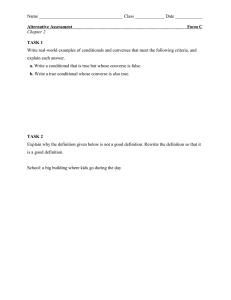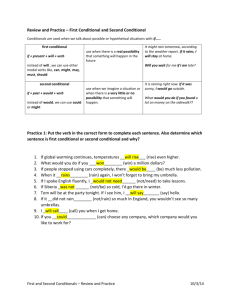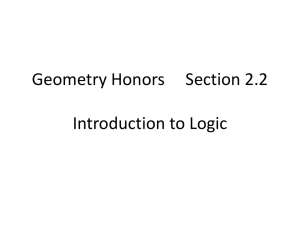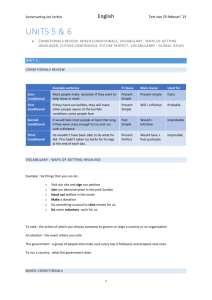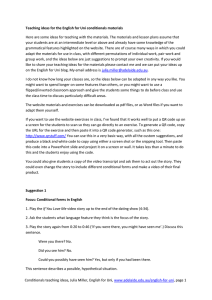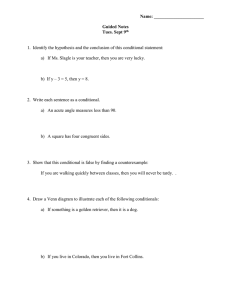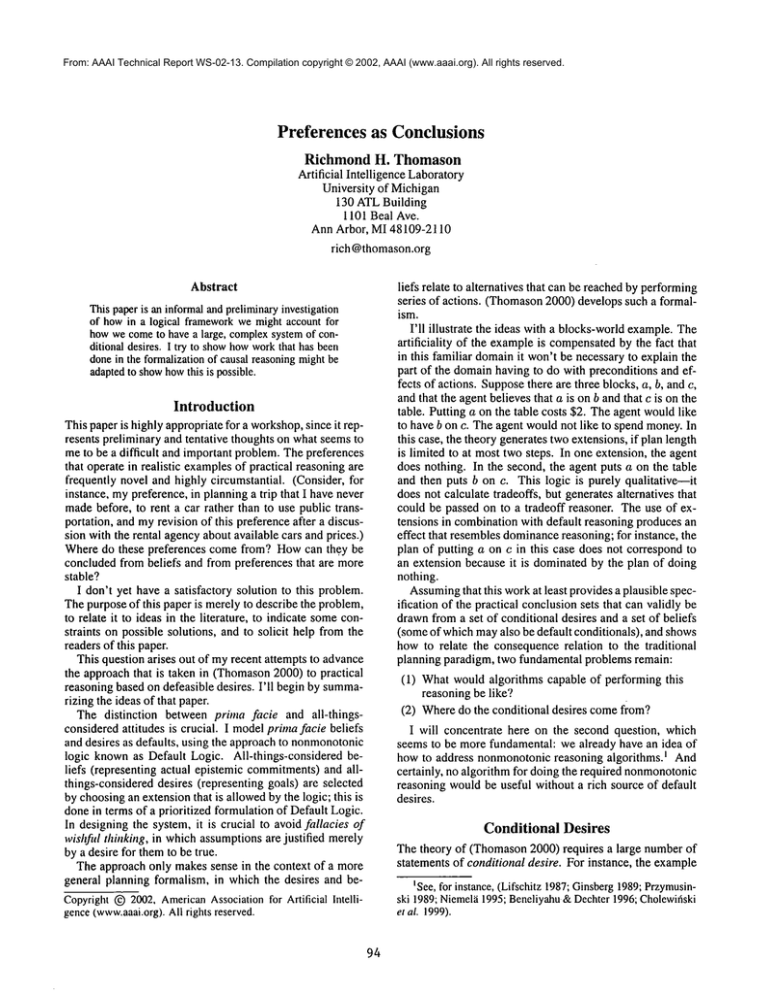
From: AAAI Technical Report WS-02-13. Compilation copyright © 2002, AAAI (www.aaai.org). All rights reserved.
Preferences as Conclusions
Richmond H. Thomason
Artificial Intelligence Laboratory
University of Michigan
130 ATLBuilding
1101 Beal Ave.
Ann Arbor, MI 48109-2110
rich @thomason.org
Abstract
Thispaperis an informaland preliminaryinvestigation
of howin a logical frameworkwe might account for
howwe cometo havea large, complexsystemof conditional desires. I try to showhowworkthat has been
donein the formalizationof causal reasoningmightbe
adaptedto showhowthis is possible.
Introduction
This paper is highly appropriate for a workshop,since it represents preliminary and tentative thoughts on what seemsto
meto be a difficult and important problem. The preferences
that operate in realistic examplesof practical reasoning are
frequently novel and highly circumstantial. (Consider, for
instance, mypreference, in planning a trip that I have never
madebefore, to rent a car rather than to use public transportation, and myrevision of this preference after a discussion with the rental agencyabout available cars and prices.)
Where do these preferences come from? Howcan they be
concluded from beliefs and from preferences that are more
stable?
I don’t yet have a satisfactory solution to this problem.
The purpose of this paper is merelyto describe the problem,
to relate it to ideas in the literature, to indicate someconstraints on possible solutions, and to solicit help from the
readers of this paper.
This question arises out of myrecent attempts to advance
the approach that is taken in (Thomason2000) to practical
reasoning based on defeasible desires. I’ll begin by summarizing the ideas of that paper.
The distinction between prima facie and all-thingsconsidered attitudes is crucial. I modelprimafacie beliefs
and desires as defaults, using the approachto nonmonotonic
logic knownas Default Logic. All-things-considered beliefs (representing actual epistemic commitments)and allthings-considered desires (representing goals) are selected
by choosingan extensionthat is allowedby the logic; this is
done in terms of a prioritized formulation of Default Logic.
In designing the system, it is crucial to avoid fallacies of
wisl~d thinking, in whichassumptions are justified merely
by a desire for themto be true.
The approach only makes sense in the context of a more
general planning formalism, in which the desires and beCopyright(~) 2002,American
Associationfor Artificial Intelligence(www.aaai.org).
All rights reserved.
94
liefs relate to alternatives that can be reachedby performing
series of actions. (Thomason2000) develops such a formalism.
I’ll illustrate the ideas with a blocks-worldexample.The
artificiality of the exampleis compensatedby the fact that
in this familiar domainit won’t be necessary to explain the
part of the domainhaving to do with preconditions and effects of actions. Supposethere are three blocks, a, b, and c,
and that the agent believes that a is on b and that c is on the
table. Putting a on the table costs $2. The agent wouldlike
to have b on c. The agent wouldnot like to spend money.In
this case, the theory generates twoextensions, if plan length
is limited to at most two steps. In one extension, the agent
does nothing. In the second, the agent puts a on the table
and then puts b on c. This logic is purely qualitative--it
does not calculate tradeoffs, but generates alternatives that
could be passed on to a tradeoff reasoner. The use of extensions in combinationwith default reasoning produces an
effect that resemblesdominancereasoning; for instance, the
plan of putting a on c in this case does not correspond to
an extension because it is dominatedby the plan of doing
nothing.
Assuming
that this workat least provides a plausible specification of the practical conclusionsets that can validly be
drawnfrom a set of conditional desires and a set of beliefs
(someof whichmayalso be default conditionals), and shows
howto relate the consequencerelation to the traditional
planning paradigm, two fundamental problems remain:
(1) What would algorithms capable of performing this
reasoning be like?
(2) Wheredo the conditional desires comefrom?
I will concentrate here on the second question, which
seems to be more fundamental: we already have an idea of
how to address nonmonotonic reasoning aigorithmsJ And
certainly, no algorithm for doing the required nonmonotonic
reasoning wouldbe useful without a rich source of default
desires.
Conditional Desires
The theory of (Thomason2000) requires a large number
statements of conditional desire. For instance, the example
tSee, for instance, (Lifschitz 1987;Ginsberg1989;Przymusinski 1989;Niemel~i1995;Beneliyahu&Dechter1996;Cholewifiski
et al. 1999).
that is elaboratedin the firstsections of the paperrequires the
following premises.
Deontological work in ethics, such as (Ross 1930), exhibits a rich, detailed systemof fairly high-level conditional
imperatives. But it is less helpful about howsuch a system
is derived, or about howto derive the conditional imperatives that actually apply to novel, detailed practical circumstances.
The conclusion appears to be that the ethical tradition in
philosophy doesn’t provide useful clues to the solution to
our problem.
Example0.1. Desires and beliefs on beginning a hike.
1. I think it will rain.
2. If it rains, I’il get wet.
3. (Even)if it rains, I wouldn’tlike to get wet.
4. If I get wet, I’d like to changeinto dry clothes.
5. If I change into dry clothes, I’ll have to walk
home.
6. If I walk home, I’ll have to walk an extra two
hours.
7. I wouldn’tlike to walk an extra two hours.
Logical
The history of the problem of deriving conditionals has
taken several turns. In mathematics,and with the traditional
logical theory of ’if’, deriving a conditional is unproblematic. Becauseconditionals are left-monotonic, any argument
from information contained in the antecedent to the consequent will suffice.
But when the logic of "counterfactual"
or leftnonmonotonicconditionals was introduced over thirty years
ago (Stalnaker 1968; Lewis1973), the problemwas reintroduced, since A -4 B does not allow [A A (7] --+ B to be
inferred in these logics. Thus, if we are in a practical situation in which we knowA holds, we can’t in general be
sure that B follows from a background theory containing
the conditional A --~ B, because, where(7 compiles all the
conditions other than Athat obtain in the given situation, we
can’t derive [A A(7] --> B.
In fact, the recent logical tradition has beenfar moresuccessful with the ontological question of under what circumstances a conditional is true than with the epistemological
question of what reasons we can have for believing conditionals. The school of thought that relates conditionals to
conditional probabilities ((Adams1975) and the work
riving from it, for instance) does address the epistemological issue. But the ideas are at best suggestive, because
the relations between conditionals and conditional probabilities are problematic, and because it isn’t easy to say
what reasons we can have for probability judgements in
specific circumstances---especially, in novel circumstances
where we do not have a good statistical model. Nevertheless, I believe that recent ideas about howwe can infer probabilities provide the most promising way to approach the
corresponding problems about conditional imperatives.
B
These premises are then formalized as follows, where
represents default belief (these are simplyrules, as in ordinary Default Logic, so they are not first-class logical citiD
zens) and ’--4 represents default desire.
Example0.1, continued. Formalizing the Premises
1. T ’---+
Background
Rain
B
2. Rain~-+ Wet
D
3. -[ ~-~ --,Wet
B
4. Wet ~-+ Change-Clothes
B
5. Change-Clothes
~-~ Home
B
6. Home ~-+ Walk-Two-Hours
B
7. T ~-~ ~Walk-Two-Hours
Ourabilities to create such conditionals are astonishingly
productive and flexible. Obviously, we don’t rememberall
of them, and we don’t simply makethemup arbitrarily. The
challenge, then, is to describe reasoning mechanismsthat
are capable of deriving a wide range of conditionals of this
sort as conclusions.
Philosophical
Background
Oneof the oldest philosophicaltraditions in ethics and practical reasoning deals with the origins of appropriate maxims for action. But this tradition is mainlyconcernedwith
whether there is an ultimate humangood, and--if there is
such a good--with how to resolve competing claims for
what it is. These high-level issues do not begin to provide
an adequate account of howwe find appropriate desires to
guide our conduct in specific circumstances. Take, for example,the utilitarian solution to the problemof the ultimate
humangood--it is whateverinduces the greatest utility for a
given population. This has the advantageof being less vague
than manyof its competitors.But still, it providesalmost no
specific guidance.
To further refine the recommendation,
let’s supposeit is
interpreted decision-theoretically, say, using the modelof
(Jeffrey 1965). Eventhen it can’t be applied, because
can never be in a position to calculate the relevant utilities
and probabilities. These methodscan be applied with some
success in policy decisions where welfare can be modeled
and probabilities estimated. But we don’t have, as far as I
know,a satisfactory account of howthis modelingand estimationcan be done; and it is highly unlikely that it can be
applied to every practical problem-solvingsituation.
More Recent
Work
Although,as far as I know,the problemof howto derive useful conditionals was not recognizedas a serious problemuntil computationallogicians beganthinking about conditionals, it was there from the first. There has been someexploration of nonmonotoniclogics involving lefi-nonmonotonic
conditionals in which[A A (7] --+ B can be inferred by default from A --+ B; see, for instance, (Asher & Morreau
1991), but these logics are complicatedto a problematicdegree, and until they are better understood,I prefer to explore
alternative approaches.
There is a school of thought according to which, as far
as reasoning is concerned, common
sense conditionals are
a more or less hopeless mess; (Goodman1955) is still the
most persuasive presentation of this point of view. I believe
95
that advances in formalizing logics of counterfactual conditionals deals well with the problemof the nonconditional
consequences of conditionals. From a contemporary perspective, I think that the mainremainingproblemsraised by
Goodman
concern howto reason to conditionals, and can be
divided into the following two questions:
(1) Under what conditions can we infer a conditional
from other conditionals? In particular, whenare we
justified in inferring [A ^ G’] --+ B from A ~ B?
(2) Under what conditions can we infer a conditional
from other evidence that maybe available in the reasoning situation?
AlthoughI amusing intuitions from conditional logics, in
what follows I amconcentrating on a formalization of conditionals as default rules. Here, the formof conditionals is
greatly simplified (there can be no nested conditionals), and
conditional inference will be a matter of inferring a default
rule from premisses that may include monotonicformulas
as well as default rules. In other words, we are thinking
of inferring defaults fromdefault theories. Ultimately,a formalization of conditional inference in this format wouldtake
the form of a strengthened definition of the extensions of a
default logic. In the simplest form of such a strengthened
definition, the extensions are formulatedusing the closure
of the actual defaults under the inferred defaults; but there
are reasons to consider morecomplexdefinitions. I will not
go into this matter here.
To a large extent, muchof the foundational logical work
in logical AI and commonsense reasoning has been concerned with these problems--though often, the work is not
presented in the formof an explicit solution to them. I want
to argue that two strands of workare particularly important
in this respect.
Work on formalizing independence
It is very plausible to say that [A ^/3] -+ C follows from
A -~ B when (1) it is possible that BACand (2) is
independentof B. For instance, suppose that I believe that
if it rains I’ll get wet, that (1) it’s possiblethat I havea dime
in mypocket and I’ll get wet and that (2) whether I have
a dimein mypocket is independentof whether it will rain.
ThenI should believe that if it rains and I havea dimein my
pocket,it will rain.
Here, we can exploit workin AI that deals with inferring
causal independence. The primary goal of (Pearl 2000)
to convincethe statistical community
of the value of reasoning explicitly about causal notions. Animportantpart of the
case Pearl makesfor this conclusion is an extendedinvestigation of howcausal independencecan be represented in
diagrammaticform and used in statistical inference. Pearl
makes a very convincing case that methods used by many
scientific communitiescan be used to modelcausal independencein familiar cases. I believe that we can use this independencemore generally, to infer conditionals by meansof
rules like the one I just described. This includes not only
plain declarative conditionals, but conditional preferences
and conditional desires.
The other ingredient in the aboveinference, possibility,
can also be approachedin familiar ways. In manyreasoning
environments,a failure to derive a contradiction from B ^ C
96
or the construction of a modelthat satisfies B ^ G’ can be
taken to establish the possibility of B ^ (7 for the purposes
of this conditional inference is concerned.
CP-Networks
CP-networks,a graphical representation and reasoning system described in (Boutilier et al. 1997), exploit graphically
represented independence information in muchthe same
wayas Bayesiannets to permit the derivation of conditional
preferences. CP-networkssupport useful algorithms for inferring conditionals; there are more recent complexity resuits in (Domschlak& Brafman2002).
However,there are important differences betweenthe way
I think abou(therole of desires in practical reasoningand the
CP-networkformalism that makeit impossible to apply the
frameworkdirectly to the problemas I have formulatedit. I
think of all-things-considered preferences (or wants) as derived by a process of tradeoff resolution from desires which,
like defaults, can compete. Preferences in CP-networksare
consistent, however,and can’t compete. Becausethey can’t
compete,they can’t be thought of as desires.
It maybe possible to develop a frameworksimilar to CPnetworksthat provides for the derivation of defeasible, competing desires. Such a frameworkwouldbe a first step towards a solution to the problem of inferring desires. At
present, I have not tried to work out the details, and-although this approach seems promising--I don’t knowhow
it will workout.
Conditionals and Frame Reasoning
There are also some useful analogies between inferringa
declarative description of a future state, and the role of
frame-basedreasoning in such inferences, and inferring the
value of a future state. Andthe analogies extend to conditionals.
In someof his recent work, John McCarthyhas suggested
that framereasoningis a wayof inferring conditionals; see,
for instance, (McCarthy& Costello 1998). Frame reasoning certainly has somethingto do with conditionals; a frame
axiomlike the one in the Yale Shooting Problemessentially
says that since the pistol is loaded now,it will be loaded
even if I wait; and ’even if’ conditionals are conditionals.
But I don’t see howto use this idea very generally, since
frame axiomsare connected to actions, and actions do not
take us from arbitrary counterfactual situations to counterfactual situations. However,it is useful, I think, to use a
situation calculus-like formalismin formalizing inference to
conditionals. Theresulting ideas are reminiscent, in a general sort of way, with framereasoning.
Let’s generalize the familiar situation-calculus formalism
to one that uses cases. (I’11 use this term because I don’t
want to use terms like ’context’ or "possible world’, and
to indicate that we are trying to formulate someaspects of
case-basedreasoning.) Like situations, cases are primitives,
and there is a Holdsrelation betweencontexts and fluents.
Let me illustrate howcausal reasoning could be used to
produce standing conditional desires with the hiking example. Supposethat I can learn about mylikes and dislikes
by experiencing myreactions to instances. I amhiking, for
instance, it rains, and I get wet. I catch a cold and experience a great deal of discomfort, whichI attribute to getting
wet, to the absence of equipmentthat wouldlet me get dry,
and to cold weather. It is important to note that here I am
assumingthat the reasoning behindthe causal attribution is
causal. The attribution takes the form of a causal explanation. The causes are divided into standing conditions ’I am
hiking’, ’the weather is cold’, ’I have no meansof getting
dry’ that are natural languagestatives, and a triggering event,
expressedby ’it rains’.
(i) c = hiking case, April 1996.
Holds(c, I have no rain gear).
Holds(c,
I am hiking).
Causes(c, It rains, I get wet).
(ii) c = hiking case, April 1996.
Holds(c, Weatheris cold).
Holds(c, I am hiking).
Holds(c, I have no meansof getting dry).
Causes(c, I get wet, I catch cold).
This experience is limited to one case. But causal explanations are intended to be general. I will suppose that
they give rise to standing conditionals. The advantage of
formalizing things this wayis that we can look at the conditionals as default generalizationsover cases. (I use the rather
vagueterm ’subsequently’to avoid getting into complexities
of temporalreasoningthat I think are irrelevant here.)
B
I get wet)
(ii’) [Holds(c, Weatheris cold)
A Holds(c, I am hiking)
A Holds(c, I have no meansof getting dry)
B
A Holds(subsequently(c),
I get wet ] ~->
Holds(subsequently(c),
I catchcold)
D
-’f- ’--+ Holds(I don’t get wet)
This is the place wheredirect, emotional reactions to circumstances produces a desire. This could be treated as a
logical inference by introducing a special constant V for
"undesirable", like the constant that is sometimesused for
similar purposes in deontic logic. But at the moment,I prefer to regard it as a direct mechanism
that creates standing
desires out of conditional beliefs together with conclusions
that are somehow
labled as directly undesirable.
Notethat this particular inferenceis simplified by the fact
that, since conditional desires are treated as primafacieattitudes, we expect them, in general, to conflict. Whenwe
infer
A,-D->/3,
because of a negative reaction to a causal consequenceof 13
in circumstancesA, there is no need for consistency checks;
we mayvery well infer
Conclusion
Suppose,now,that the hiker is in a different context which
is similar to the other one.
(iii) c = Currenthiking case.
Holds(c, Weatheris cold).
Holds(c, I have no rain gear).
Holds(c, I have no meansof getting dry).
Holds(c, I am hiking).
Now,in general we can’t infer A ---> /3 from t3 and
[A A13] --+ C in conditionallogic. But this too is one of the
inferences we can make if A and/3 are causally independent. So, on the assumptionthat the three premissesof (iii)
are causally independent, we can infer the following about
the current hiking case. (Noteagain that the standing conditional (ii’) applies in the current case becauseit is a generalization overcases.)
(iv) c = Current hiking case.
B
Holds(c, I get wet)
Holds(subsequently(c),
(iv) c = Current hiking case.
from a negative reaction to someother causal consequence
of 13 in circumstancesA.
Notethat the final default desire that is inferred here is the
D
premiseT ,----> ~Wetthat I neededin the earlier paper.
This exampleinvolves a direct experience, but we are able
to enlarge the conditional desires we can learn in this wayby
imagination: weconstruct hypothetical situations, and arrive
at conditional desires by considering the vicarious reaction
we have to the hypothetical circumstances. This is not as
vivid as real experience,but is far safer.
(i’) [Holds(c, I have no rain gear)
A Holds(c, I am hiking)
AHolds(c,It rains] ’---->
Holds(subsequently(c),
The experience of the cold was unpleasant; again, there
is a causal relation betweenthe cold and the unpleasantness.
This, finally, will induce the inference of a desire (which,
under the circumstances, is unconditional).
I catch cold)
97
The mainanswer that I amcurrently exploring to the question of howwe seem to be able to infer such a large and
flexible set of conditional desires is (like so manycurrent
approaches) causal. Weare constructed to recognize the
causal features of our experiences. This structures themin a
waythat supports general conditional beliefs, applicable to
a wide variety of circumstances. Wehavedirect reactions to
manysimple propositions; we can use these to form conditional desires fromconditional beliefs.
I realize that, presentedin this form,the ideas are abstract
and sketchy. But the abstractions I amusing actually arose
out of a consideration of manyreasoning examples, and I
believe that they do provide useful suggestions about how
to carry out the reasoning. The problem, of course, is to
provide more detail about the reasoning mechanismsthat
could realize this sort of reasoning, with the ultimate goal
of producinga testable reasoningarchitecture. This is not a
short-range task, but I amworking on someof the simpler
reasoning mechanisms, and I hope to have something specific to say aboutat least someof the details of the reasoning
architecture very soon.
References
Adams,E. W.1975. The Logic of Conditionals. Dordrecht:
D. Reidel Publishing Co.
Asher, N., and Morreau, M. 1991. Commonsenseentailment: a modal theory of nonmonotonicreasoning. In Mylopoulos, J., and Reiter, R., eds., Proceedingsof the Twelfth
b~ternational Joint Conferenceon Artificial Intelligence,
387-392. Los Altos, California: MorganKaufmann.
Beneliyahu, R., and Dechter, R. 1996. Default reasoning
using classical logic. Artificial Intelligence 84(1-2):113150.
Boutilier, C.; Brafman,R.; Geib, C.; and Poole, D. 1997.
A constraint-based approach to preference elicitation and
decision making.In Doyle, J., and Thomason,R. H., eds.,
WorkingPapers of the AAAISpring Symposiumon Qualitative Preferences in Deliberation and Practical Reasonhrg,
19-28. MenloPark, California: AmericanAssociation for
Artificial Intelligence.
Cholewifiski,
P.; Mikitiuk, A.; Marek, W.; and
Truszczyfiski, M. 1999. Computingwith default logic.
Artificial Intelligence 112:105-146.
Domschlak, C., and Brafman, R.I. 2002. CP-nets-reasoning and consistency checking. In Fensel, D.;
Giunchiglia, F.; McGuinness,D.; and Williams, M.-A.,
eds., KR2002:Principles of KnowledgeRepresentation
and Reasoning. San Francisco, California: MorganKaufmann. 121-132.
Ginsberg, M. L. 1989. A circumscriptive theorem prover.
Artificial Intelligence 39(2):209-230.
Goodman,N. 1955. Fact, Fiction and Forecast. Harvard
University Press.
Jeffrey, R. C. 1965. The Logic of Decision. NewYork:
McGraw-Hill,1 edition.
Lewis, D. K. 1973. Counterfactuals. Cambridge, Massachusetts: HarvardUniversity Press.
Lifschitz, V. 1987. Computingcircumscription. In Ginsberg, M. L., ed., Readings in NonmonotonicReasoning.
Los Altos, California: MorganKaufmann.167-173.
McCarthy,L, and Costello, T. 1998. Useful counterfactuals
and approximatetheories. In Ortiz, Jr., C. L., ed., Working
Notes of tire AAAI Sprhrg Symposiumon Prospects for a
CommonsenseTheory of Causation, 44-51. Menlo Park,
CA:AmericanAssociation for Artificial Intelligence.
Niemel~i,I. 1995. Towardsefficient default reasoning. In
Mellish, C., ed., Proceedhrgsof the Fourteenth International Joint Conferenceon Artificial Intelligence, 312-318.
San Francisco: Morgan Kaufmann.
Pearl, J. 2000. Causality: Models, Reasoning, and Inference. Cambridge,England: CambridgeUniversity Press.
Przymusinski, T. C. 1989. An algorithm to computecircumscription.Artificial bltelligence 38(1):49-73.
Ross, W. 1930. Tire Right and tire Good. Oxford: Oxford
University Press.
Stalnaker, R. C. 1968. A theory of conditionals. In Rescher,
N., ed., Studies in Logical Theory. Oxford: Basil Blackwell
Publishers. 98-112.
98
Thomason,R. H. 2000. Desires and defaults: A framework for planning with inferred goals. In Cohn, A. G.;
Giunchiglia, E; and Selman, B., eds., KR2000:Principles of Knowledge Representation and Reasoning, 702713. San Francisco: Morgan Kaufmann.

